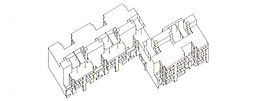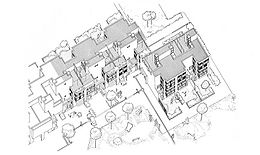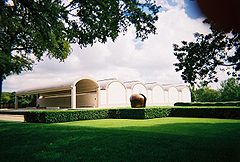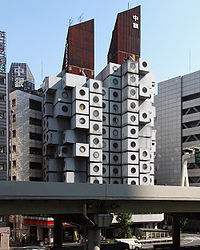.gif)
Structuralism (architecture)
Encyclopedia



Congrès International d'Architecture Moderne
The Congrès internationaux d'architecture moderne – CIAM was an organization founded in 1928 and disbanded in 1959, responsible for a series of events and congresses arranged around the world by the most prominent architects of the time, with the objective of spreading the principles of the Modern...
(Rationalism
New Objectivity (architecture)
The New Objectivity is a name often given to the Modern architecture that emerged in Europe, primarily German-speaking Europe, in the 1920s and 30s. It is also frequently called Neues Bauen...
), which had led to a lifeless expression of urban planning that ignored the identity of the inhabitants and urban forms.
Two different manifestations of Structuralist architecture exist. Sometimes these occur in combination with each other. On the one hand, there is the Aesthetics of Number, formulated by Aldo van Eyck
Aldo van Eyck
Aldo van Eyck or van Eijk was an architect from the Netherlands.-Family:...
in 1959. This concept can be compared to cellular tissue. The "Aesthetics of Number" can also be described as "Spatial Configurations in Architecture".
On the other hand, there is the Architecture of Lively Variety (Structure and Coincidence), formulated for user participation in housing by John Habraken
N. John Habraken
N. John Habraken is a Dutch architect, educator, and theorist. His major contributions are in the field of mass housing and the integration of users and residents into the design process.-Biography:...
in 1961. Also, in the 1960s many well-known utopian projects are based on the principle of "Structure and Coincidence". Similar notions of "Architecture of Lively Variety" are: "Architecture of Diversity", "Pluralistic Architecture" or "Two-Components-Approach".
Structuralism
Structuralism
Structuralism originated in the structural linguistics of Ferdinand de Saussure and the subsequent Prague and Moscow schools of linguistics. Just as structural linguistics was facing serious challenges from the likes of Noam Chomsky and thus fading in importance in linguistics, structuralism...
in a general sense is a mode of thought of the 20th century, which came about in different places, at different times and in different fields. It can also be found in linguistics, anthropology, philosophy and art.
Origins
Structuralism in architecture and urban planning had its origins in the Congrès International d'Architecture Moderne (CIAM) after World War II. Between 1928 and 1959, the CIAM was an important platform for the discussion of architecture and urbanism. Various groups with often conflicting views were active in this organization; for example, members with a scientific approach to architecture without aesthetic premises (RationalistsNew Objectivity (architecture)
The New Objectivity is a name often given to the Modern architecture that emerged in Europe, primarily German-speaking Europe, in the 1920s and 30s. It is also frequently called Neues Bauen...
), members who regarded architecture as an art form (Le Corbusier
Le Corbusier
Charles-Édouard Jeanneret, better known as Le Corbusier , was a Swiss-born French architect, designer, urbanist, writer and painter, famous for being one of the pioneers of what now is called modern architecture. He was born in Switzerland and became a French citizen in 1930...
), members who were proponents of high- or low-rise building (Ernst May
Ernst May
Ernst May was a German architect and city planner.May successfully applied urban design techniques to the city of Frankfurt am Main during Germany's Weimar period, and in 1930 less successfully exported those ideas to Soviet Union cities, newly created under Stalinist rule...
), members supporting a course of reform after World War II (Team 10), members of the old guard and so on.
Individual members of the small splinter group Team 10 laid the foundations for Structuralism. The influence of this team was later interpreted by second generation protagonist Herman Hertzberger
Herman Hertzberger
Herman Hertzberger is a Dutch architect and emeritus professor.-Biography:Herman Hertzberger was born on 6 July 1932 in Amsterdam, Netherlands....
when he said: "I am a product of Team 10." As a group, Team 10 was active from 1953 onwards, and two different movements emerged from it: the New Brutalism of the English members (Alison and Peter Smithson
Alison and Peter Smithson
English architects Alison Smithson and Peter Smithson together formed an architectural partnership, and are often associated with the New Brutalism .Peter was born in Stockton-on-Tees in north-east England, and Alison was born in Sheffield, South Yorkshire...
) and the Structuralism of the Dutch members (Aldo van Eyck
Aldo van Eyck
Aldo van Eyck or van Eijk was an architect from the Netherlands.-Family:...
and Jacob Bakema).



Louis Kahn
Louis Isadore Kahn was an American architect, based in Philadelphia, Pennsylvania, United States. After working in various capacities for several firms in Philadelphia, he founded his own atelier in 1935...
in the United States, Kenzo Tange
Kenzo Tange
was a Japanese architect, and winner of the 1987 Pritzker Prize for architecture. He was one of the most significant architects of the 20th century, combining traditional Japanese styles with modernism, and designed major buildings on five continents. Tange was also an influential protagonist of...
in Japan and John Habraken
N. John Habraken
N. John Habraken is a Dutch architect, educator, and theorist. His major contributions are in the field of mass housing and the integration of users and residents into the design process.-Biography:...
in the Netherlands (with his theory of user participation in housing). Herman Hertzberger and Lucien Kroll made important architectural contributions in the field of participation. In this context, Hertzberger made the following statement: "In Structuralism, one differentiates between a structure with a long life cycle and infills with shorter life cycles."
In 1960, the Japanese architect Kenzo Tange
Kenzo Tange
was a Japanese architect, and winner of the 1987 Pritzker Prize for architecture. He was one of the most significant architects of the 20th century, combining traditional Japanese styles with modernism, and designed major buildings on five continents. Tange was also an influential protagonist of...
designed his well-known Tokyo Bay Plan. Reflecting later on the initial phase of that project, he said: "It was, I believe, around 1959 or at the beginning of the sixties that I began to think about what I was later to call Structuralism", (cited in Plan 2/1982, Amsterdam). Tange also wrote the article "Function, Structure and Symbol, 1966", in which he describes the transition from a functional to a structural approach in thinking. Tange considers the period from 1920 to 1960 under the heading of "Functionalism"
Congrès International d'Architecture Moderne
The Congrès internationaux d'architecture moderne – CIAM was an organization founded in 1928 and disbanded in 1959, responsible for a series of events and congresses arranged around the world by the most prominent architects of the time, with the objective of spreading the principles of the Modern...
and the time from 1960 onwards under the heading of "Structuralism".
Le Corbusier
Le Corbusier
Charles-Édouard Jeanneret, better known as Le Corbusier , was a Swiss-born French architect, designer, urbanist, writer and painter, famous for being one of the pioneers of what now is called modern architecture. He was born in Switzerland and became a French citizen in 1930...
created several early projects and built prototypes in a Structuralist mode, some of them dating back to the 1920s. Although he was criticized by the members of Team 10 in the 1950s for certain aspects of his work (urban concept without a "sense of place" and the dark interior streets of the Unité), they nevertheless acknowledged him as a great model and creative personality in architecture and art.
Manifesto
One of the most influential manifestos for the Structuralist movement was compiled by Aldo van EyckAldo van Eyck
Aldo van Eyck or van Eijk was an architect from the Netherlands.-Family:...
in the architectural magazine Forum 7/1959. It was drawn up as the programme for the International Congress of Architects in Otterlo in 1959
Congrès International d'Architecture Moderne
The Congrès internationaux d'architecture moderne – CIAM was an organization founded in 1928 and disbanded in 1959, responsible for a series of events and congresses arranged around the world by the most prominent architects of the time, with the objective of spreading the principles of the Modern...
. The central aspect of this issue of Forum was a frontal attack on the Dutch representatives of CIAM-Rationalism
New Objectivity (architecture)
The New Objectivity is a name often given to the Modern architecture that emerged in Europe, primarily German-speaking Europe, in the 1920s and 30s. It is also frequently called Neues Bauen...
who were responsible for the reconstruction work after World War II, (for tactical reasons, planners like van Tijen, van Eesteren, Merkelbach and others were not mentioned). The magazine contains many examples of and statements in favour of a more human form of urban planning. This congress in 1959 marks the official start of Structuralism, although earlier projects and buildings did exist. Only since 1969 has the term "Structuralism" been used in publications in relation to architecture.
Otterlo Congress, Participants
Some of the presentations and discussions that took place during the Otterlo Congress in 1959Congrès International d'Architecture Moderne
The Congrès internationaux d'architecture moderne – CIAM was an organization founded in 1928 and disbanded in 1959, responsible for a series of events and congresses arranged around the world by the most prominent architects of the time, with the objective of spreading the principles of the Modern...
are seen as the beginning of Structuralism in architecture and urbanism. These presentations had an international influence. In the book "CIAM '59 in Otterlo", the names of the 43 participating architects are listed:
L. Miquel, Alger / Aldo van Eyck
Aldo van Eyck
Aldo van Eyck or van Eijk was an architect from the Netherlands.-Family:...
, Amsterdam / José A. Coderch, Barcelona / Wendell Lovett
Wendell Lovett
Wendell Harper Lovett is a significant Pacific Northwest architect and teacher.Born and raised in Seattle, Washington, Lovett entered the University of Washington program in architecture in 1940, but his college years were interrupted by wartime service. He graduated from the University of...
, Bellevue-Washington / Werner Rausch, Berlin / W. van der Meeren, Bruxelles / Ch. Polonyi, Budapest / M. Siegler, Genf / P. Waltenspuhl, Genf / Hubert Hoffmann, Graz / Chr. Fahrenholz, Hamburg / Alison Smithson, London / Peter Smithson, London / Giancarlo de Carlo
Giancarlo De Carlo
Giancarlo De Carlo was an Italian architect.He was born in Genoa, Liguria in 1919. He trained as an architect from 1942 to 1949, a time of political turmoil which generated his philosophy toward life and architecture...
, Milan / Ignazio Gardella
Ignazio Gardella
Ignazio Gardella was an Italian architect and designer.-Biography:Born into a family of architects, the first of which was his namesake Ignazio Gardella , he graduated in engineering from the Politecnico di Milano university in 1928 .In his university...
, Milan / Vico Magistretti
Vico Magistretti
Vico Magistretti was an Italian industrial designer, known as a furniture designer and architect.-Education:...
, Milan / Ernesto Nathan Rogers
Ernesto Nathan Rogers
Ernesto Nathan Rogers was an Italian architect, writer and educator.-Biography:Born in Trieste, Italy he graduated from the Politecnico di Milano, Italy in 1932...
, Milan / Blanche Lemco van Ginkel, Montreal / Sandy van Ginkel
Sandy van Ginkel
Harmen Peter Daniel van Ginkel, CM was a Dutch and Canadian architect and urban planner. He was a leading force in the planning efforts surrounding Expo 67....
, Montreal / Callebout, Nieuport / Geir Grung, Oslo / A. Korsmo, Oslo / Georges Candilis, Paris / Alexis Josic, Paris / André Wogenscky, Paris / Shadrach Woods
Shadrach Woods
Shadrach Woods was an American architect, urban planner and theorist. Schooled in engineering at New York University and in literature and philosophy at Trinity College, Dublin, Woods joined the Paris office of Le Corbusier in 1948...
, Paris / Louis Kahn
Louis Kahn
Louis Isadore Kahn was an American architect, based in Philadelphia, Pennsylvania, United States. After working in various capacities for several firms in Philadelphia, he founded his own atelier in 1935...
, Philadelphia / Viana de Lima, Porto / F. Tavora, Porto / Jacob B. Bakema
Jacob B. Bakema
Jacob Berend Bakema was a Dutch modernist architect, notable for his public housing and involvement in the reconstruction of Rotterdam after the Second World War....
, Rotterdam / Herman Haan, Rotterdam / J.M. Stokla, Rotterdam / John Voelcker, Staplehurst / Ralph Erskine
Ralph Erskine
Ralph Erskine is the name of:*Ralph Erskine , British-Swedish architect*Ralph Erskine , the 18th century Scottish clergyman...
, Stockholm / Kenzo Tange
Kenzo Tange
was a Japanese architect, and winner of the 1987 Pritzker Prize for architecture. He was one of the most significant architects of the 20th century, combining traditional Japanese styles with modernism, and designed major buildings on five continents. Tange was also an influential protagonist of...
, Tokyo / T. Moe, Trondheim / Oskar Hansen, Warszawa / Zofia Hansen, Warszawa / Jerzy Soltan, Warszawa / Fred Freyler, Wien / Eduard F. Sekler, Wien / Radovan Niksic, Zagreb / Alfred Roth, Zurich
Theoretical Origins


- Built structures corresponding in form to social structures, according to Team 10 (Working group for the investigation of interrelationships between social and built structures) .
- The archetypical behaviour of man as the origin of architecture (cf. Anthropology, Claude Lévi-StraussClaude Lévi-StraussClaude Lévi-Strauss was a French anthropologist and ethnologist, and has been called, along with James George Frazer, the "father of modern anthropology"....
). Different Rationalist architects had contacts with groups of the Russian Avant-Garde after World War I. They believed in the idea that man and society could be manipulated.
- Coherence, growth and change on all levels of the urban structure. The concept of a Sense of place. Tokens of identification (identifying devices). Articulation of the built volume.
- Polyvalent form and individual interpretations (compare the concept of langue et parole by Ferdinand de SaussureFerdinand de SaussureFerdinand de Saussure was a Swiss linguist whose ideas laid a foundation for many significant developments in linguistics in the 20th century. He is widely considered one of the fathers of 20th-century linguistics...
). User participation in housing. Integration of "high" and "low" culture in architecture (fine architecture and everyday forms of building). Pluralistic architecture.
The principle Structure and Coincidence remains relevant until now, both for housing schemes and urban planning. For housing schemes the following images were influential: the perspective drawing of the project "Fort l'Empereur" in Algiers by Le Corbusier
Le Corbusier
Charles-Édouard Jeanneret, better known as Le Corbusier , was a Swiss-born French architect, designer, urbanist, writer and painter, famous for being one of the pioneers of what now is called modern architecture. He was born in Switzerland and became a French citizen in 1930...
(1934) and the isometric drawing of the housing scheme "Diagoon" in Delft by Herman Hertzberger
Herman Hertzberger
Herman Hertzberger is a Dutch architect and emeritus professor.-Biography:Herman Hertzberger was born on 6 July 1932 in Amsterdam, Netherlands....
(1971). At city level, important projects were: the Tokyo Bay Plan of Kenzo Tange
Kenzo Tange
was a Japanese architect, and winner of the 1987 Pritzker Prize for architecture. He was one of the most significant architects of the 20th century, combining traditional Japanese styles with modernism, and designed major buildings on five continents. Tange was also an influential protagonist of...
(1960) and the fascinating images of the model of the Free University of Berlin by Candilis Josic & Woods
Shadrach Woods
Shadrach Woods was an American architect, urban planner and theorist. Schooled in engineering at New York University and in literature and philosophy at Trinity College, Dublin, Woods joined the Paris office of Le Corbusier in 1948...
(1963). Also worth mentioning are the utopias of Archigram
Archigram
Archigram was an avant-garde architectural group formed in the 1960s - based at the Architectural Association, London - that was futurist, anti-heroic and pro-consumerist, drawing inspiration from technology in order to create a new reality that was solely expressed through hypothetical projects...
and Yona Friedman
Yona Friedman
Yona Friedman is a Hungarian-born French architect, urban planner and designer. He became famous in the late 1950s and early 1960s, in the so-called age of megastructures.-Early years:...
. In general, instruments for urban structuring are: traffic lines (e.g. gridiron plans), symmetries, squares, remarkable buildings, rivers, seashore, green areas, hills etc. This methods were also used in previous cities.
The principle Aesthetics of Number proved to be less useful for structuring an entire city. However, exemplary articulated configurations did arise, both in architecture and housing schemes. The first influential images for this direction Aldo van Eyck
Aldo van Eyck
Aldo van Eyck or van Eijk was an architect from the Netherlands.-Family:...
provided with aerial photos of his orphanage in Amsterdam (1961). Later he built another inspiring configuration for the Space Centre Estec in Noordwijk (1989). These two compositions can be counted among the most beautiful "icons" of structuralism.
Housing Estates, Buildings and Projects
Atelier 5: Halen housing estateHalen Estate
The Halen Estate is a housing development near Berne, Switzerland. It was designed and built by the Atelier 5 architectural partnership from 1957–1961...
near Bern, 1961
Van den Broek & Bakema et al.: New Rotterdam districts: Pendrecht project 1949 / Alexanderpolder projects 1953 and 1956
Piet Blom
Piet Blom
Piet Blom was a Dutch architect best known for his 'Kubuswoningen' built in Helmond in the mid-1970s and in Rotterdam in the early 1980s. He studied at the Amsterdam Academy of Building-Arts as a student of Aldo van Eyck.Piet Blom, Aldo van Eyck, Herman Hertzberger a.o...
: Kasbah housing estate in Hengelo, 1973 / Urban district Oude Haven in Rotterdam, 1985
Candilis Josic & Woods
Shadrach Woods
Shadrach Woods was an American architect, urban planner and theorist. Schooled in engineering at New York University and in literature and philosophy at Trinity College, Dublin, Woods joined the Paris office of Le Corbusier in 1948...
: Free University of Berlin, 1963–73
Craig Zeidler & Strong
Eberhard Zeidler
Eberhard Heinrich Zeidler, OC, O.Ont is a Canadian architect.he studied at the Technische Hochschule, Karlsruhe, Germany....
: McMaster University Medical Centre in Hamilton Canada, 1972
Giancarlo De Carlo
Giancarlo De Carlo
Giancarlo De Carlo was an Italian architect.He was born in Genoa, Liguria in 1919. He trained as an architect from 1942 to 1949, a time of political turmoil which generated his philosophy toward life and architecture...
: Student housing Collegio del Colle Urbino, 1966
Adriaan Geuze
West 8
West 8 is an urban planning and landscape architecture firm founded by Adrian Geuze in the Netherlands. It is known for its contemporary designs and innovative solutions to urban planning problems using lighting, metal structures, and color....
et al.: New urban district Borneo-Sporenburg Scheepstimmermanstraat in Amsterdam, 1997 (participation)
Herman Hertzberger
Herman Hertzberger
Herman Hertzberger is a Dutch architect and emeritus professor.-Biography:Herman Hertzberger was born on 6 July 1932 in Amsterdam, Netherlands....
: Centraal Beheer office building in Apeldoorn, 1972 (participation, inside) / Diagoon, eight experimental houses in Delft, 1971 (participation)
Louis Kahn
Louis Kahn
Louis Isadore Kahn was an American architect, based in Philadelphia, Pennsylvania, United States. After working in various capacities for several firms in Philadelphia, he founded his own atelier in 1935...
: Jewish Community Center in Trenton, project 1954 / Salk Institute in La Jolla California, 1965 / Kimbell Art Museum in Fort Worth, 1972
Lucien Kroll
Lucien Kroll
Lucien Kroll is a Belgian architect well-known for this projects involving participation by the future users of the buildings. His most famous work is the Medical Faculty Housing, at the University of Louvain, Belgium, from 1970-76.-External links:*...
: Students' Centre St. Lambrechts-Woluwe in Brussels, 1976 (participation)
Kisho Kurokawa: Nakagin Capsule Tower in Tokyo, 1972
Le Corbusier
Le Corbusier
Charles-Édouard Jeanneret, better known as Le Corbusier , was a Swiss-born French architect, designer, urbanist, writer and painter, famous for being one of the pioneers of what now is called modern architecture. He was born in Switzerland and became a French citizen in 1930...
: Perspective drawing of new city district Fort l'Empereur in Algiers, project 1934 (participation) / Weekend house near Paris, 1935 / Centre Le Corbusier in Zurich, 1967
Renzo Piano
Renzo Piano
Renzo Piano is an Italian architect. He is the recipient of the Pritzker Architecture Prize, AIA Gold Medal, Kyoto Prize and the Sonning Prize...
& Richard Rogers
Richard Rogers
Richard George Rogers, Baron Rogers of Riverside CH Kt FRIBA FCSD is a British architect noted for his modernist and functionalist designs....
: Centre Georges-Pompidou in Paris, 1977
Renzo Piano
Renzo Piano
Renzo Piano is an Italian architect. He is the recipient of the Pritzker Architecture Prize, AIA Gold Medal, Kyoto Prize and the Sonning Prize...
: Zentrum Paul Klee, Museum in Bern, 2005
Richard Rogers
Richard Rogers
Richard George Rogers, Baron Rogers of Riverside CH Kt FRIBA FCSD is a British architect noted for his modernist and functionalist designs....
: Madrid-Barajas Airport terminal 4, 2006
Moshe Safdie
Moshe Safdie
Moshe Safdie, CC, FAIA is an architect, urban designer, educator, theorist, and author. Born in the city of Haifa, then Palestine and now Israel, he moved with his family to Montreal, Canada, when he was 15 years old.-Career:...
: Habitat '67 housing estate, World Exposition in Montréal, 1967 / The Children's Monument Yad Vashem in Jerusalem, 2005
Alison and Peter Smithson
Alison and Peter Smithson
English architects Alison Smithson and Peter Smithson together formed an architectural partnership, and are often associated with the New Brutalism .Peter was born in Stockton-on-Tees in north-east England, and Alison was born in Sheffield, South Yorkshire...
: Golden Lane housing estate in London, project 1952 / Urban-planning scheme 1953: Hierarchy of Association "house-street-district-city"
Kenzo Tange
Kenzo Tange
was a Japanese architect, and winner of the 1987 Pritzker Prize for architecture. He was one of the most significant architects of the 20th century, combining traditional Japanese styles with modernism, and designed major buildings on five continents. Tange was also an influential protagonist of...
: Tokyo Bay Plan, project 1960 / Yamanashi Culture Chamber in Kofu, 1967
Aldo van Eyck
Aldo van Eyck
Aldo van Eyck or van Eijk was an architect from the Netherlands.-Family:...
: Orphanage in Amsterdam, 1960 / European Space Research and Technology Centre Estec, restaurant conference-hall library in Noordwijk, 1989
Verhoeven Klunder Witstok & Brinkman: Housing estate in Berkel-Rodenrijs near Rotterdam, 1973
Stefan Wewerka: New city district Ruhwald in Berlin, project 1965
Interrelationships Between Social and Built Structures (Team 10)
1) "De Drie Hoven" Residential Building for Elderly People in Amsterdam-SlotervaartAmsterdam
Amsterdam is the largest city and the capital of the Netherlands. The current position of Amsterdam as capital city of the Kingdom of the Netherlands is governed by the constitution of August 24, 1815 and its successors. Amsterdam has a population of 783,364 within city limits, an urban population...
, 1974 (Herman Hertzberger
Herman Hertzberger
Herman Hertzberger is a Dutch architect and emeritus professor.-Biography:Herman Hertzberger was born on 6 July 1932 in Amsterdam, Netherlands....
). - 2) "Kasbah" Housing Estate in Hengelo
Hengelo
Hengelo is a municipality and a city in the eastern Netherlands, in the province of Overijssel. The city lies along the motorways A1/E30 and A35 and it has a station for the International Amsterdam – Hannover – Berlin service.-Traffic and transport:...
, 1973 (Piet Blom
Piet Blom
Piet Blom was a Dutch architect best known for his 'Kubuswoningen' built in Helmond in the mid-1970s and in Rotterdam in the early 1980s. He studied at the Amsterdam Academy of Building-Arts as a student of Aldo van Eyck.Piet Blom, Aldo van Eyck, Herman Hertzberger a.o...
).

